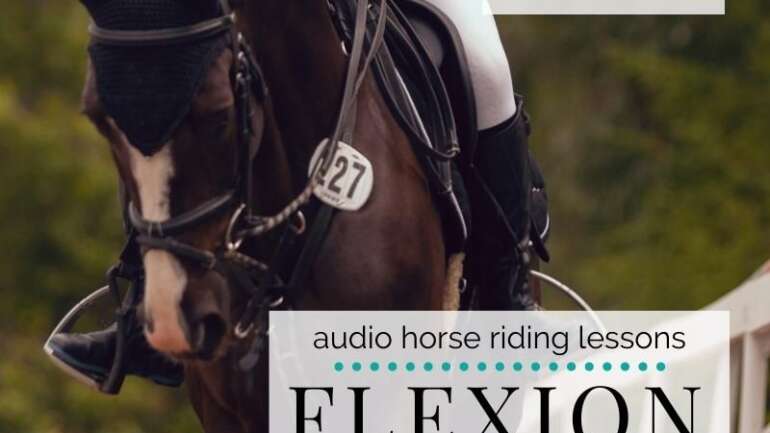I find it a little mind-boggling how, the longer we spend developing ourselves as riders, the more we need to unlearn. Especially when it comes to those first one or two initial horse riding lessons!
Using your hands and arms to ‘steer’ the horse is one of those things. And, flexion is often one of the best concepts to help riders become clearer on this. And more open to other possibilities when it comes to their aids, their riding, and steering their horse.
Flexion versus Bending
Flexion is bending. In the truest definition of the word, it is often attributed to the bending of a limb; an arm or leg. And when we are talking horses, this can also be true. Many vets will do a flexion test to assess soundness.
However, flexion when riding is a little more subtle. instead of it being a bend, it is more like a suggestion towards a bend…
I often describe it to my younger riders as being like the indicator lights on a car (also called blinkers, or turn signals). The point is that the indicator merely suggests to other drivers that you’re about to go a certain way, but they don’t actually steer the car.
I feel that ‘bending’ while riding is more about the channel of the energy. Where the energy flows as the horse and rider move together.
When Do We Use Flexion
As I said, flexion can often suggest or indicate to your horse other things. So, for example, if you were preparing to track to the left, you could ask for a slight flexion to the left first. Or if you were preparing to ask for canter on the right lead, you could ask for flexion to the right first.
When I’m in the saddle, I like to think of flexion as being a very subtle ‘nod’ in the right direction. Like a little prompt or cue for your horse to follow.
Flexion is also how we determine ‘outside and inside’ when it comes to our aids. Flexion to the right will result in your right side becoming your inside. And therefore your left side becomes your outside.
So rather than using your position in the arena to determine inside and outside aids, the flexion of the horse will dictate what’s what 🙂
Flexion for Suppleness
Finally, flexion can be introduced to your daily riding work in order to increase suppleness throughout your horse’s body. And I think this is the key defining element when it comes to really understanding flexion and its true meaning when we are working, training, and developing horses.
As riders, we can use slight but very intentional flexion as a tool to help develop suppleness and increase elasticity throughout our horse’s bodies
This brings me to go a little deeper into the word ‘slight’. I’ve already mentioned that bending is more of a way to channel the energy through a turn, on a circle, or around a corner.
Flexion, when riding, is often far more subtle than bending, and can be achieved anywhere in the ride; riding on the straight or through a bend
True Suppleness = Flow & Ease
And what makes flexion so important is that, for many horses, this slight shift in how they carry themselves can allow new pathways to open. Both in how they ‘think’ they can work. And in how their body actually can work.
Flexion is often the key to softening something that has become hard or rigid – and this is because true flexion allows the energy to continue to flow
So in instances where a true bend is difficult for the horse and rhythm or relaxation is lost, flexion can be a great introduction to the whole ‘idea’. This is while still moving forward in relaxation and rhythm. A good example of this is introducing shoulder-fore before riding true shoulder-in.
Also, because flexion is ‘slight’ and merely an indicator, the horse learns to continue to move forward until another aid or another question is asked
By working on developing true flexion, even the slightest incline towards it, the horse will begin to create new ways of using his body. And continuing to implement previous training principles.
Start on the Ground
So, like so many things to do with horses, the best place to begin your work with flexion is on the ground. Beside, not on, your horse. I will do a follow-up training on this which you can get delivered to your phone by ENTERING YOUR DETAILS HERE.
Begin Implementing Flexion into Your Riding
From here, you can begin to work on this principle with your horse using a simple technique that I will talk about in a step-by-step audio training. This training will be delivered a day after the first one for groundwork. Make sure you DOWNLOAD THE FREE TRAINING HERE
This is a key concept that can literally transform both you and your horse. From being hollow and wooden to becoming more ‘loosey goosey’, supple, and ‘able’ in your work together.
Happy Riding
Lorna
Get Support & Guidance in Your Riding
-
-
- Understanding Inside and Outside in Your Riding
- Turning Your Horse Versus Asking Your Horse to Turn
- Creating Space for Better Canter Transitions
- How to Ride a Circle with Your Horse
- Riding Through a Bend; Understanding Your Role
- Weight Aids and Seat Bones for Turning and Bending
- Asking Your Horse to Bend
-

